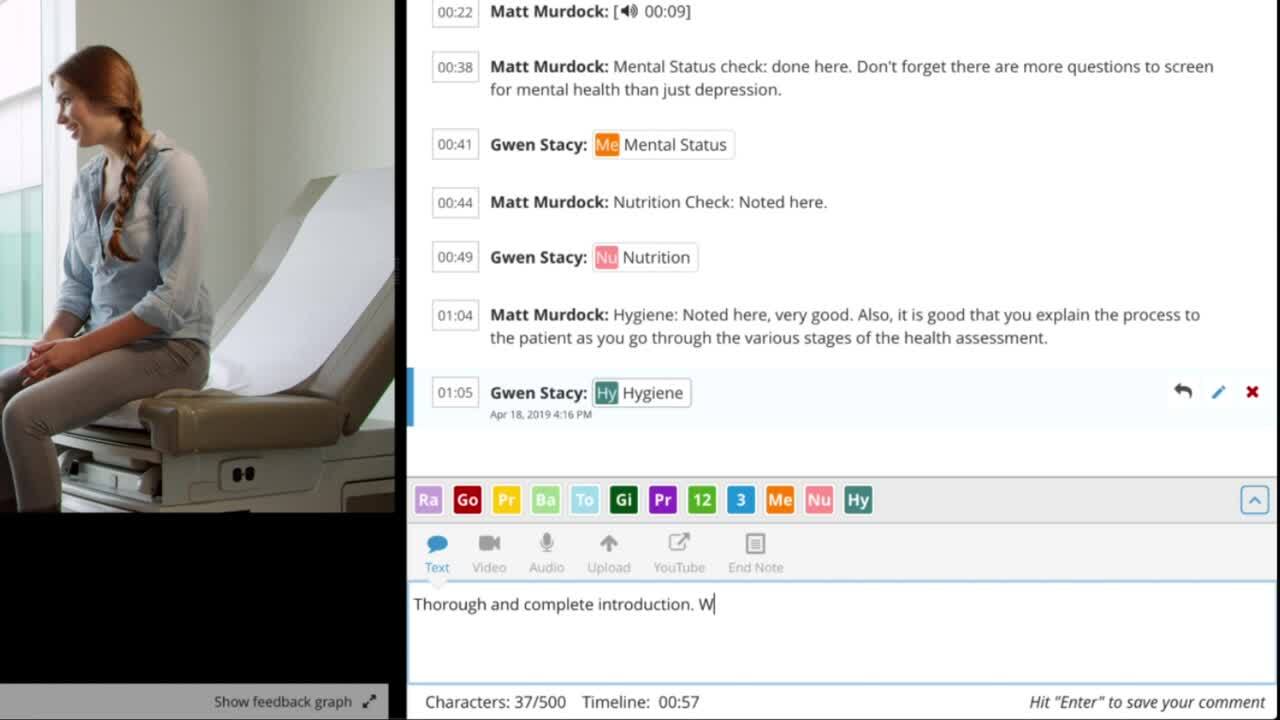Are newly minted graduates prepared to do a nursing head-to-toe assessment?
Not many. According to a study published in Nursing Education, “only 11 of 40 RN graduates entering the transition program scored 70% or better on physical assessment skills testing.”
But professors and departments are discovering helpful tools to address the problem head-on. A tool for closing the preparation-practice gap is assigning a student head-to-toe assessment video.
Want to better prepare your nursing students? Download our head-to-toe assessment checklist that highlights the most regularly performed skills in an entry-level practice.
The Advantages of Student Videos
Utilizing student videos to teach nursing assessments isn’t a new idea—especially when it comes to teaching the health assessment in nursing.
The advantages of assigning a student head-to-toe assessment videos stretches back several decades. In 2003, a group of faculty members at Central Missouri State University baccalaureate school of nursing (CMSU) published an article about incorporating video recordings as a technique to teach the nursing head-to-toe assessment.
From that early time (even with limited budget and equipment) the CMSU educators found that video “alleviate[d]” a lot of the “problems with traditional one-on-one validation of skills.”
Namely, video technology facilitated more specific and detailed feedback. As a result, educators noticed that student assessments and specific psychomotor skills improved. Students also reported “better skill acquisition and increased self-confidence.”
(Oh, and did I mention that filming the head-to-toe assessment gave educators a lot of flexibility when it came to observing and grading?)
Today
Fast forward to 2018, Christina Purpora and Susan K. Prion found similar results surveying students that completed a head-to-toe assessment video assignment. They observed that their “nursing students felt able to apply classroom learning of this skill to clinical practice, and the process encouraged the development of their self-reflection skills.”
So to summarize the advantages of assigning a student head-to-toe assessment video:
1. Flexibility for students and faculty
Students don’t have to rely on a rare simulation lab opening to record their head-to-toe assessment. They just need their smartphone propped up against some books and a willing participant to be the patient.
2. More opportunities for practice
If students performed a nursing head-to-toe assessment in a simulation lab, they would only get one chance. But with a student head-to-toe video assignment, your students can record can record themselves as many times as they want and turn in their best take.
3. Students see their mistakes
With this assignment, students are faced with irrefutable evidence of their mistakes. That’s one of the reasons research shows that when students see their mistakes visually, they learn skills crazy fast.
4. Students can correct their mistakes
Your students can watch their videos immediately and compare their performance with the head-to-toe assessment checklist. This makes students more self-sufficient and more prepared.
5. More effective debriefing
Even relying on primitive recording technology in 2003, research published by Central Missouri State University baccalaureate school of nursing (CMSU) noted the improved quality of their feedback by responding to student videos.
6. Increased student confidence
Practicing more and being able to watch their practice gives your students more confidence in performing a nursing head-to-toe assessment.
7. More self-reflection
Self-reflection is a hard skill to teach students, but you will notice increased awareness as students record, practice, and review their recordings of performing a head-to-toe assessment.
The Challenges of Nursing Video Assessments
Yet that’s not to say that using video for a nursing assessment is without challenges. In 2003, CSMU students and faculty faced technology-related issues. Technology and logistics continues to cause challenges for instructors today, which is curious because technology has advanced so practically every teacher and student has a phone in their pocket.
Today
Whether it’s figuring out how students will access video recording technology (the university video lab or cell phones), determining how students will turn it in (flash drive, online website, cloud software), making sure you’ve downloaded compatible software to watch all the student submissions, or devising an effective accompanying feedback method (google docs, excel, or word).
Luckily, there are solutions that remove the technological and logistical friction in assigning a head-to-toe assessment video.
The Video Software Solution
One solution is GoReact. This video assessment tool can solve the headaches that come with assigning a health assessment student video.
Smaller Video Files
Video submissions are automatically compressed and accessible to the professor.
Simple Equipment
Students can film themselves with their own smartphones and laptops. Students can access an easy-to-use tools to pause, clip, or re-film a segment.
Integrated Feedback
Professors can give time-stamped feedback and customized markers directly on the student submitted video.
Accessible Feedback
Immediately after a professor finalizes their review, students can access and respond directly to their professor’s feedback.
So the right tool can help mitigate historic challenges in assigning a head-to-toe assessment video. Also keep in mind that even in the early 2000s, nursing educators believed the benefits of a student video health assessment far outweighed these early challenges. That means there is even less reason for nursing educators today to not employ the student video for the physical assessment in nursing.
Bridge the Gap with Video
To return to where this article started, the theory-practice gap in nursing puts nursing students in a difficult if not perilous situation. That’s why nursing educators should be doing everything within their power to bridge this gap.
Since evidence shows that student videos can help bridge the nursing gap, nursing educators should seriously consider a student video for teaching the nursing head-to-toe assessment. Newly graduated RNs perform this assessment far too often during their work day for nursing educators to not provide every advantage possible.
Whether you use GoReact or another video tool, nursing professors must seriously consider video to help bridge the gap in teaching the nursing head-to-toe assessment.
If you’d like more ideas for teaching physical assessments, read 7 Tips for Teaching the Head-to-Toe Assessment.






